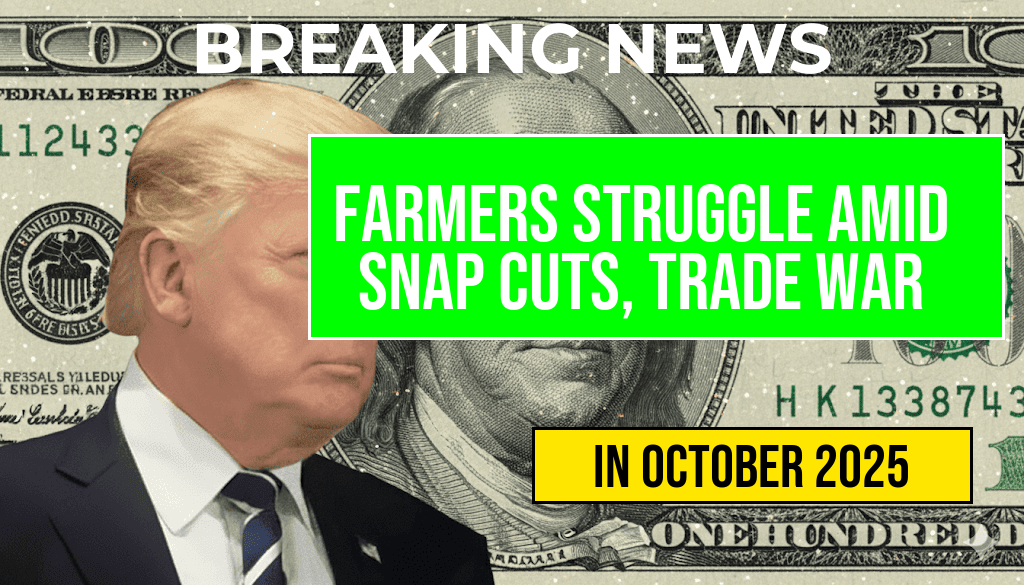Farmers across the United States are grappling with significant financial challenges as reductions in the Supplemental Nutrition Assistance Program (SNAP) and ongoing trade tensions exacerbate their economic woes. Recent reports indicate that many agricultural operations are losing thousands of dollars annually, putting immense pressure on their viability. The intertwining effects of SNAP cuts, which directly impact food purchasing power for millions of Americans, alongside retaliatory tariffs and trade restrictions, are creating a perfect storm for the farming community. With these factors at play, farmers are not only struggling to maintain profitability but are also concerned about their long-term sustainability.
Impact of SNAP Reductions
The SNAP program, a cornerstone of food assistance for low-income families, has seen budget cuts that directly affect consumers’ ability to purchase food. According to the U.S. Department of Agriculture, SNAP benefits help millions of Americans secure necessary nutrition, which in turn drives demand for agricultural products. As more families face reduced benefits, farmers report declining sales, leading to an estimated loss of $10,000 to $30,000 per farm annually.
Trade War Consequences
Simultaneously, the ongoing trade war has resulted in tariffs that have raised costs for farmers and reduced their access to critical export markets. The economic fallout from these trade disputes has led to a decrease in the competitiveness of American agricultural products abroad, with many farmers reporting a direct hit to their bottom lines. This situation has been exacerbated by retaliatory tariffs imposed by countries that previously imported significant quantities of U.S. agricultural goods.
Financial Strain Across the Sector
The cumulative impact of these challenges is evident across various segments of the farming industry. A survey conducted by the American Farm Bureau Federation highlighted that over 60% of farmers indicated financial distress due to these factors. Here are some specific areas of concern:
- Crops: Many crop farmers have seen prices plummet, especially for commodities like soybeans and corn, which have been heavily affected by trade tariffs.
- Dairy: The dairy sector faces additional pressure from reduced consumer spending, with many families opting for less expensive alternatives.
- Livestock: Rising feed costs, driven by both trade issues and supply chain disruptions, have further squeezed profit margins for livestock producers.
Long-Term Sustainability Concerns
As farmers continue to navigate these turbulent waters, questions about long-term sustainability loom large. Many are left wondering how they will maintain their operations if these challenges persist. The combination of lower demand due to SNAP cuts and fluctuating prices caused by trade disputes has created an environment where planning for the future becomes increasingly difficult.
Support and Solutions
In response to these pressures, advocacy groups are calling for renewed support from the federal government. There are ongoing discussions about enhancing SNAP benefits and providing farmers with better access to financial assistance programs. Some potential solutions suggested include:
- Increasing SNAP funding to bolster consumer purchasing power.
- Implementing programs to help farmers manage price volatility.
- Encouraging local food systems that can reduce dependence on exports.
Conclusion
The current landscape for American farmers is marked by uncertainty and financial strain as they face the dual challenges of SNAP reductions and an ongoing trade war. As these issues unfold, the future of farming in the United States may depend on the ability of policymakers to respond effectively to the needs of both consumers and producers. The hope is that through collaborative efforts, the agricultural sector can find a path toward recovery and resilience.
Frequently Asked Questions
What are the main reasons for the financial strain on farmers?
The financial strain on farmers is primarily due to reductions in SNAP benefits and the ongoing trade war, which have collectively resulted in thousands of dollars lost per farm.
How have SNAP reductions impacted farmers?
SNAP reductions have led to decreased consumer spending on food, which directly affects farmers’ income and sales, causing significant financial challenges.
What are the consequences of the trade war for farmers?
The trade war has introduced tariffs and trade barriers, leading to reduced market access and lower prices for crops, which further exacerbates the financial difficulties faced by farmers.
Are there any support measures in place for affected farmers?
While there may be some government assistance programs available, many farmers still struggle to navigate the complexities of these programs amidst the financial turmoil.
What can farmers do to mitigate financial losses?
Farmers can explore various strategies such as diversifying crops, seeking new markets, and utilizing financial planning resources to help mitigate their losses during these challenging times.






